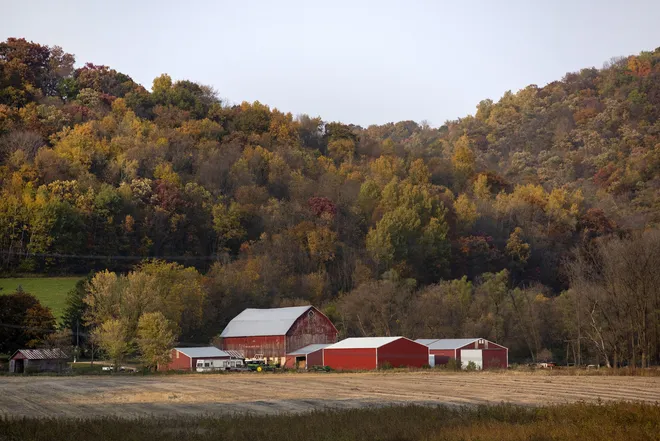Historian chronicles changes to America’s agriculture from WWI through the Cold War
Published: 3 June 2025
By Tervor Hook
via the Wisconsin State Farmer website

84004350007-coon-valley-farm-angela-major-wpr
A farm in Coon Valley, Wis., is surrounded by fall colors Friday, Oct. 9, 2020. (Photo by Angela Major/WPR)
A new book makes the case that farmers in Wisconsin and throughout the Midwest were not bystanders to America’s rise as a world superpower — but key to its ascent in the first half of the 20th century.
In “Global Heartland: Cultivating the American Century on the Midwestern Farm” author Peter Simons explores the role farmers in Wisconsin, Minnesota and throughout the Midwest played in America’s rise to power, from massively bolstering production in World War I to supplying American allies like Great Britain in World War II.
Simons told WPR’s “Wisconsin Today” that this chapter of American history challenges stereotypes of American farmers as isolationist or disconnected from a changing world.
“They weren’t just accepting what others were serving up, but they saw their work as essential to building a world that came after,” Simons said.The book comes as the Trump administration has enacted a slew of tariffs on nearly all imported products to the United States, sparking fears of a recession as consumer confidence fell to a five-year low in April.
The Trump administration has claimed, in part, that tariffs are to bolster domestic production — echoing arguments on tariffs and America’s role abroad that government officials made nearly a century ago.
“It’s obviously a bit different now than it was in the 1940s and 1950s,” Simons said. “But [newly announced tariffs] are really reversing 60 or 70 years of American agricultural policy, foreign policy and really the fundamental sense of Americans and how they relate to the rest of the world.”
Simons explained how Midwestern farmers not only were crucial for America’s ascent to power in the 1900s, but also experienced historic benefits from international involvement themselves.
The following was edited for clarity and brevity.
Kate Archer Kent: I was astounded at how Wisconsin’s agricultural production skyrocketed in 1918 during World War I. Wisconsin produced the most oats in the nation, more corn than it had ever grown, and enough wheat and rye to make the state self-sustaining. What increased our state’s output this much?
Peter Simons: There are a number of different factors, but the most basic one is that it turned out to be incredibly profitable during the war because there was an incredible demand for these products. So farmers would divert other crops into those that were most needed overseas and start growing more than they ever had before.
The other thing that happens is agricultural technology, like tractors, had been in development for quite some time leading up until World War I. With the sudden loss of farm hands, family members, whoever was going either to fight abroad or they were going to factories to make the weapons that were going to be used abroad … there was a shortfall in agricultural labor. And so the very rapid adoption of these technologies helped create higher yields than states like Wisconsin had ever seen before.
Of course, because they’re building tanks and trucks and all these other things that they need for war, there’s not enough material to actually build all the tractors that are needed. So the state agricultural departments will send out bulletins telling you how to try to craft your own tractor or create your own plow. This is a moment where we see really intensified adoption of agricultural technology.
→ Read the entire article on the Wisconsin State Farmer website.
External Web Site Notice: This page contains information directly presented from an external source. The terms and conditions of this page may not be the same as those of this website. Click here to read the full disclaimer notice for external web sites. Thank you.



